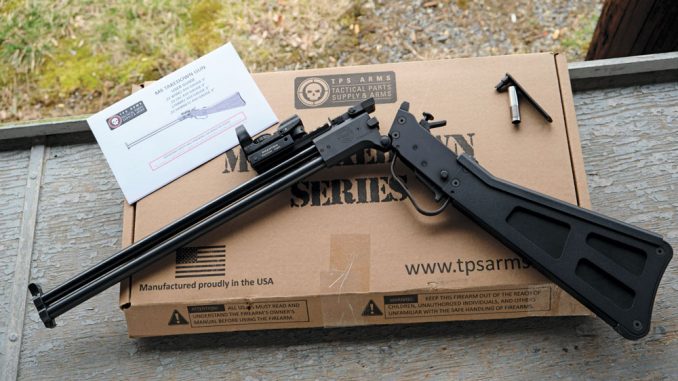
TPS Arms’ New .357/.410 Ups The Ante.
The United States Air Force began issuing the M6 Aircrew Survival Weapon to aircrews in 1952. The M6 comprised dual, 14-inch, over/under .22 Hornet/.410 shotgun barrels mated to a receiver made from stamped sheet metal containing the trigger group, storage space and a hinged takedown assembly. The weapon was to be no longer than 15 inches when folded for storage, and crews were instructed to wrap the barrels with paracord to serve as a makeshift forend.
Unlike most military weapons, the M6 Aircrew Survival Weapon was never intended for combat. Its sole purpose was to assist downed aircrews in foraging for wild game in a survival situation. Production of the military M6 ceased in the early 1970s.

Minus the optic, this is what comes in the box with a new TPS Arms M6.
The original M6 had 14-inch barrels, so the National Firearms Act restricted its ownership by civilians. As a result, the military-issue M6 was never sold to the public. Even so, the utility of the design of the M6 was not lost on the shooting public, and Springfield Armory stepped in to provide civilians with a slightly modified version of the original M6 until its production was discontinued in 2008.
New Beginnings
When Jeff Paulson opened Tactical Parts Supply and Arms (TPS Arms), he started by producing high-quality parts for the AR15 platform. He recognized that the long-discontinued M6 Scout platform might well be one of the best survival guns ever made. So, he set out to build his own improved version of the gun.
TPS Arms introduced its own M6 Scout rifle to the public in 2018. Until now, the TPS Arms M6 has been available in .22LR, .22 Magnum, .17 HMR and .22 Hornet. All configurations were combined with a .410 shotgun barrel with a 3-inch chamber and interchangeable choke tubes. Compared to the military and Springfield M6, all the TPS M6 variants featured a long list of improvements.
While hunting larger game is possible using the original caliber lineup of the M6, Paulson recognized that the existing calibers were less than ideal for that purpose. Additionally, many states have regulations making it illegal to hunt animals such as deer and bear with a .22-caliber weapon.

While very similar to its predecessor from Springfield Armory (right), The TPS Arms M6 Scout brings some very welcome improvements.
Magnum M6
After much consideration, it was decided that the new M6 would incorporate a .357 Magnum rifle barrel. The .357 Magnum is a pistol caliber developed for combat revolvers, but it takes on a whole, new personality when fired from a carbine-length barrel.

The M6 features dual barrels and an enhanced extractor. The match-grade .357 Magnum barrel resides on the top, closest to the sighting plane.
The .357 Magnum packs a lot of punch using full-power loads; it’s also extremely versatile. There’s a huge variety of .357 Magnum ammunition, ranging from 110-grain, high-velocity loads to heavy-hitting 180-grain loads. As with any .357 Magnum rifle, the M6 can also fire .38 Special ammunition, further increasing its versatility.
Product Improvements
The original military-issue M6 was purpose built for utility and versatility in a compact design. It was issued to many aircrews flying in arctic environments during the Cold War. The original M6 had no mechanical safety. Its “safe” condition was with its hammer down. The trigger comprised a large bar that was designed to be squeezed and could easily be operated when wearing bulky gloves or mittens. There was also no trigger guard to get in the way. The trigger pull of the original and the Springfield M6 took a “considerable” amount of effort.
The TPS Arms M6 remains true to the original design by keeping the unique trigger bar setup. However, TPS Arms understood that maintaining accuracy with the heavy trigger pull of the original M6 was challenging (I’ve owned a Springfield Armory M6 for many years and can attest that its trigger is less than ideal for accuracy!).

The trigger mechanism remains true to the original design but has been greatly improved, making this a much more “shootable” gun.
While the TPS Arms trigger bar will never be considered “match grade,” it’s a vast improvement over my old Springfield. The pull is lighter and feels more consistent and controllable. As with the Springfield M6, the TPS model includes a large trigger guard.
A feature unique to the TPS M6 is the inclusion of a crossbar button safety. This safety allows the M6 to be safely carried with the hammer cocked with rounds in the chambers. The safety is built into the stamped sheet metal receiver and is easy to reach and operate. With a bit of practice, the user can learn to switch the safety off and on with virtually no noise—crucial in a hunting environment. Because the safety is unprotected, I’d still recommend carrying the M6 in the hammer-down position most of the time. However, when actively hunting with the TPS M6, this safety is a very welcome addition.

The unprotected crossbolt safety allows the TPS Arms M6 to have a much better trigger than the original while still being very safe to use and hunt with.
The double-barrel design of the TPS M6 requires the use of two separate firing pins. To select which barrel to fire, a large, knurled knob selector is built into the hammer. The knob is attached to a metal block that, when moved, will determine which barrel is selected. The block has three positions: Pulling the knob all the way to the top will select the rifle barrel. Pushing it all the way to the bottom selects the shotgun barrel. A neutral, middle position is also available. This is a safety feature that ensures the firing pin block won’t engage either barrel. While this is a highly effective safety feature, relying on it while hunting would be a mistake, because moving the hammer selector is noisy and is sure to alert game.

The large disc built into the hammer allows the user to select which barrel to fire, as well as place the hammer in a safe, neutral position
The .410 barrel now incorporates removable choke tubes. My copy of the M6 was delivered with both modified and full choke tubes and a tool to remove and replace them. The front sight incorporated with the barrel assembly now includes two protective wings and a sight post that’s adjustable for elevation. The same tool that’s used for the choke tubes can make front sight adjustments.

The TPS Arms M6 is delivered with two interchangeable choke tubes for the .410 shotgun barrel. Full and modified chokes are provided with each gun, along with a tool to change them. An improved choke is available as an option.

Each M6 Scout comes with a multi-tool for installing and removing the choke tubes.

The multi-tool also doubles as a front sight adjustment tool.
The M6 has always included a storage system in the buttstock. Because the stock assembly is made from stamped sheet metal, its hollow interior was used to store extra ammunition. My Springfield M6 uses a rubberized sheet metal cover that’s hinged to the stock to cover the storage area and also provide a more comfortable place to get a cheek weld.
TPS Arms made some much-appreciated improvements in this area. The hinged cover on the TPS gun is made from glass-reinforced nylon. It has a latch assembly that’s much easier to engage, and the cover is wider and more radiused, making it much more comfortable when shooting.

The Exotac nanoSTRIKER XL ferro rod fits perfectly in a .410 ammo compartment in the stock of the rifle.
TPS has made further improvements inside the storage compartment. Instead of the storage compartment being “hard wired” into the stock, the TPS system uses modular plastic organizers to hold extra ammunition. There’s also a small compartment for storing a few small items.

One of the many improvements to the TPS Arms M6 is the inclusion of extra storage space in the buttstock.

With the exception of the WC Knives Woodsman EDC knife, all items pictured fit inside the buttstock—with room to spare for ammo.
The last notable—and perhaps the biggest—improvement that TPS has made is in the hinge assembly of the gun. As noted before, the M6 system consists of two major components: The forward assembly contains the barrels, chambers and sights. The rear assembly comprises the stock and fire-control group. Both sections mate together via a hinge held in place by a large pin. When fully assembled, both sections are held in place by the main hinge pin and a large hinged locking block assembly.

On the old versions of the M6, the takedown pin was not captured and, therefore, easily lost. This led to many improvised takedown pins being made. However, the pin on the TPS Arms M6 (top) is fully captured. No more lost pins!
The hinge pin is removable on the military and Springfield M6. This pin was notorious for getting lost; a lost hinge pin renders the weapon unusable. TPS addressed this major design flaw using its expertise in making AR15 components. It designed the pin on the TPS Arms M6 much the same as the takedown pins on an AR15. The pin can be moved, allowing it to be completely taken down. However, instead of being removable, it’s captured in the hinge assembly of the stock. Voilà! No more lost hinge pins!
Taking the M6 to the Range
My sample copy of the new M6 was delivered in the beginning days of the coronavirus outbreak here, in the United States. Obtaining a variety of factory ammunition became very difficult.
My eyes aren’t what they used to be, and I wanted to give the TPS Arms M6 every opportunity to show its accuracy potential. Unfortunately, the sight I had arranged to use on the M6 was significantly delayed. Ultimately, all accuracy testing was done using an Aimpoint Micro H-1 with a 4 MOA dot. This wasn’t my first choice for testing the accuracy potential of the rifle barrel, but the Aimpoint Micro showed itself to be an outstanding choice and complemented the M6 very well.
You will also note that most of the ammunition used in this review comprised handloads that I made. Because of the ammunition shortage brought on by the pandemic, this was the only way I could collect any appreciable amount of data on the gun’s performance. (Note: Please understand that the use of handloaded ammunition will officially void the warranty of the TPS Arms M6.)

Accuracy testing was conducted using an Aimpoint Micro H-1. The .38 Special and .357 Magnum loads were tested at 50 yards, while shot loads were tested at 20 yards.
All firearms have particular preferences with the ammunition that they like to shoot accurately. Even firearms of the same type from the same manufacturer will show different preferences.
I tested the M6 with a wide variety of loads ranging from lightweight .38 Special to heavy .357 Magnum. I did all testing of the rifle barrel from a shooting rest at 50 yards. Velocities were measured 9 feet from the muzzle of the rifle. I tested the shotgun at 20 yards using both the full and modified choke tubes and using realistic targets.
While my range-testing is far from conclusive, you can see that the TPS Arms M6 Scout shows great potential for both accuracy and the ability to take larger game animals. With groups as small as ¾ inch at 50 yards, it definitely has the accuracy to take game at reasonable distances. (See the Accuracy Results and Handloaded Ammunition sidebars below.)
There’s much more to the game-taking potential of a round than the kinetic energy it produces, but I’ve included it here as a point of reference. The typical .223 Remington rifle round, as fired by the AR15 rifle, will produce approximately 1,296 foot-pounds of energy. The 7.62×39 cartridge fired by the AK47 produces an average of 1,527 foot-pounds of energy.
The kinetic energy leaders from the M6, firing .357 Magnum ammunition, produced 1,270 and 1,465 foot-pounds of energy! Understanding that bullet selection must be matched to the game being hunted, and that pistol bullets will shed velocity and energy much more quickly than their rifle bullet counterparts, we’re still left with the fact that the .357 Magnum fired from the TPS Arms M6 is a force to be reckoned with.
Shotgun Results
On the day I conducted the shotgun portion of this testing, I attempted to use a cheap red-dot sight. This was a big mistake, and I dismissed all accuracy testing from that day. Nevertheless, the M6 proved capable of placing game-taking shot patterns on target at 20 yards using both the modified and full chokes.

Even with the Aimpoint H-1 Micro sight zeroed at 50 yards for the rifle barrel, shotshell placement was well-centered when placing the dot on the target at 20 yards.

While issues with the original optic caused some erratic shot placement, the .410 barrel was able to provide solid, game-getting patterns on this life-sized turkey target.
I fired a few rounds of Winchester 3-inch, ¼-ounce slugs from the TPS M6. With my Springfield Armory M6, .410 slugs are the only “heavy-caliber” option available. This isn’t the case with the TPS Arms M6, and I can see no reason to resort to using them when other options are available.

This target (hand-painted by the author’s daughter!) was shot with Winchester 3-inch, #7 shot game loads at 20 yards using the modified choke tube.


Sighting Options
As delivered from TPS Arms, the M6 Scout has a protected front sight post that’s adjustable for elevation, a rear flip sight with a peep aperture for the rifle and a shallow V-notch for the .410. The sights are simple, rugged and entirely adequate for shooting at reasonable distances.

The .410 sight is a shallow V-notch that’s easily flipped up when needed.

The M6 uses a fixed peep sight for the rifle barrel
The M6 provided for this review also came pre-installed with a short Picatinny scope base. This allows the user to install a wide variety of optics.
I tried to fit the M6 with a few of the spare scopes that have accumulated in my gun parts box over the years. Unfortunately, I couldn’t fit any of them to the gun because of clearance issues caused by the scope rings I had on hand.
On the day before the statewide coronavirus lockdown took effect, I took delivery of the parts needed to install my Aimpoint Micro H-1 red-dot sight. While it isn’t the ideal sight for pure accuracy testing, it proved to be a “marriage made in heaven,” as far as practicality and usability are concerned. The Aimpoint is renowned for its rugged durability and a battery life that’s measured in years, not hours. Its small profile adds very little weight to the M6 and points naturally. I found that even when sighted in for the .357 Magnum, the Aimpoint was an effective sighting tool for the .410—with no adjustments needed.
Next-Level Design
The original M6 Scout was designed to assist the user in foraging for edible game animals. In its original configuration, the M6 Scout is a capable tool for procuring small game.
TPS Arms has taken the M6 design to the next level. The improved trigger pull and addition of a crossbolt safety have transformed the M6 from a utilitarian survival tool to a viable hunting weapon. The addition of adjustable iron sights and improved stock ergonomics help make the M6 much more user-friendly.

The M6 Scout is a rugged, lightweight hunting weapon that’s capable of taking a wide variety of game animals.
By replacing the standard .22-caliber rifle barrel with a quality .357 Magnum rifle barrel, the TPS Arms M6 has been elevated to new levels of versatility. Using the .410 barrel with a good shotshell load allows the user to take all manner of small game animals. The rifle barrel can be loaded with ammunition that will allow it to be used for everything from small-game hunting to deer—and even bear.
I’ve hunted with my old Springfield Armory M6 many times over the years to gain proficiency with it. While it proved to be effective, it was always less than ideal and rarely enjoyable to use. The improvements that TPS Arms has made to its M6 have not only made it a more efficient hunting weapon, they’ve also made it fun to use.
As soon as the pandemic restrictions are lifted, I’ll be taking the new M6 back to the range and into the hunting fields!
Editor’s note: A version of this article first appeared in the August, 2020 print issue of American Survival Guide.
The post THE M6 TAKEDOWN RIFLE HITS THE BIG TIME appeared first on American Survival Guide.





Be the first to comment